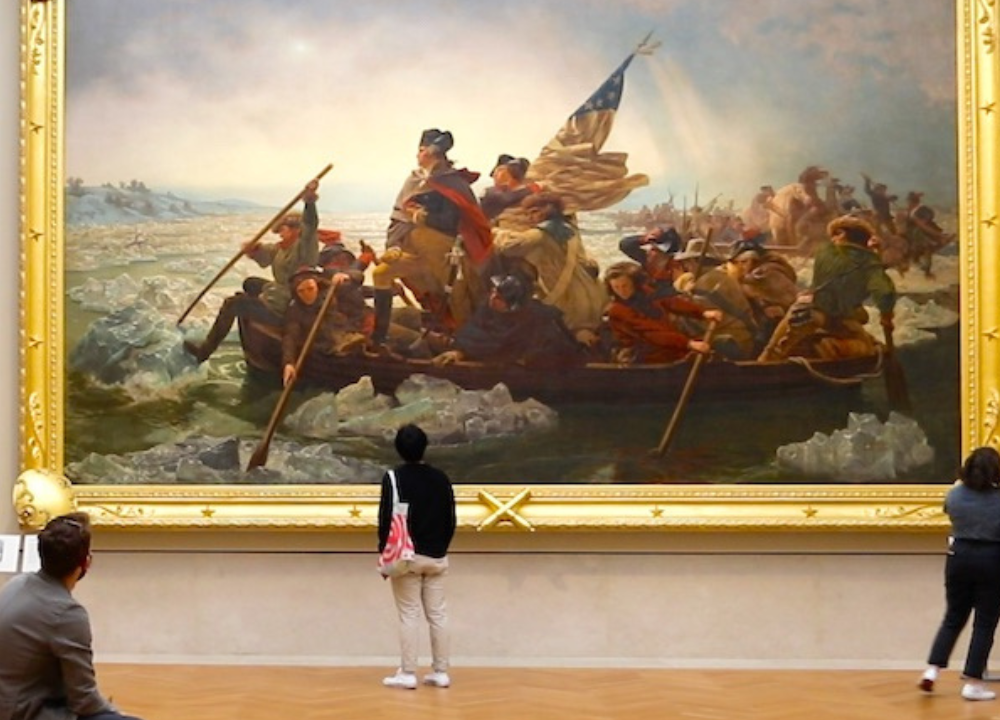Imagine standing on the edge of a rocky precipice, gazing out at a vast sea of swirling fog. This is the world captured in Caspar David Friedrich’s iconic painting, “Wanderer above the Sea of Fog.”
You might feel a mix of awe and introspection as you take in the powerful imagery. This artwork invites you to explore themes of nature, solitude, and the human experience. As you delve deeper into this masterpiece, you’ll uncover the emotions and meanings that Friedrich infused into every brushstroke.
What does the figure in the painting represent? How does the fog symbolize the mysteries of life? By understanding the context and significance of “Wanderer above the Sea of Fog,” you can gain new insights into your own journey. Stay with us as we explore the captivating details of this artwork. You might just find a reflection of your own thoughts and feelings in the mist. Let’s uncover the layers of meaning together.
Artist Background
Caspar David Friedrich created many powerful paintings. One of his most famous works is Wanderer above the Sea of Fog. This painting shows a man standing on a rocky cliff, gazing at a mysterious sea of fog. Understanding Friedrich’s background helps us appreciate his art even more.
Early Life
Caspar David Friedrich was born on September 5, 1774, in Greifswald, Germany. He grew up in a coastal town. Nature surrounded him, which influenced his work.
Education
Friedrich studied at the University of Greifswald. Later, he attended the Academy of Fine Arts in Copenhagen. His education helped him develop his unique style.
Artistic Influences
- Romanticism: Friedrich was part of the Romantic movement. This style focused on emotion and nature.
- Nature: He often painted landscapes. Nature was his main subject.
- Philosophy: Friedrich’s art reflected deep thoughts about life and existence.
Career Highlights
| Year | Event |
|---|---|
| 1809 | First major exhibition in Berlin. |
| 1820 | Created Wanderer above the Sea of Fog. |
| 1840 | Named a professor at the Academy of Fine Arts in Dresden. |
Legacy
Friedrich passed away on May 7, 1840. His works continue to inspire artists today. Wanderer above the Sea of Fog remains a symbol of Romantic art.
Painting Description
The painting “Wanderer above the Sea of Fog” by Caspar David Friedrich is a striking image. It captures a man standing on a rocky cliff, gazing into a vast sea of fog. The painting evokes feelings of awe and contemplation. It reflects the Romantic spirit of the early 19th century. The viewer is drawn into a world of mystery and nature’s beauty. This section will explore the visual elements, color palette, and composition techniques used in this iconic artwork.
Visual Elements
Friedrich’s “Wanderer above the Sea of Fog” is rich with visual elements that create a powerful impact. The main focus is the figure of the wanderer. He stands confidently, dressed in a dark green coat and a black hat. This contrast highlights his presence against the soft fog. The background features rolling hills and mountains, shrouded in mist. The fog creates a sense of depth and distance.
- Figure: The wanderer symbolizes exploration and introspection.
- Landscape: Mountains fade into the fog, suggesting mystery.
- Texture: The rough rocks contrast with the smooth fog.
The painting’s foreground includes sharp, dark rocks. These rocks anchor the viewer’s eye. The figure stands on them, representing a bridge between man and nature. The overall scene invites viewers to ponder their place in the world.
Color Palette
The color palette of “Wanderer above the Sea of Fog” is essential to its emotional tone. Friedrich uses a limited range of colors. Greens, blues, and grays dominate the scene. These colors create a calm yet mysterious atmosphere.
| Color | Emotion/Effect |
|---|---|
| Dark Green | Nature and tranquility |
| Soft Blue | Depth and serenity |
| Gray | Mystery and uncertainty |
The cool tones contribute to the painting’s overall mood. The fog is painted in subtle shades of gray and white. This adds to the sense of ethereality. The color choices enhance the feeling of solitude and contemplation. Viewers can feel the chill of the fog and the weight of the moment.
Composition Techniques
Friedrich employs various composition techniques to guide the viewer’s eye. The wanderer is positioned slightly off-center. This creates a dynamic balance in the painting. The use of leading lines draws attention to the figure.
- Rule of Thirds: The figure occupies a third of the canvas.
- Foreground Interest: Rocks in the foreground create depth.
- Negative Space: The foggy sky emphasizes the figure’s isolation.
The layering of elements enhances the sense of depth. The fog obscures the background, creating a sense of mystery. The composition invites viewers to explore the scene. Each element works together to reflect the themes of solitude and nature.
Symbolism In The Artwork
The painting “Wanderer above the Sea of Fog” by Caspar David Friedrich is a powerful representation of human emotion and nature. The artwork is rich in symbolism, conveying themes of exploration and introspection. The figure stands atop a rocky precipice, gazing into a vast sea of fog, evoking feelings of mystery and wonder. This artwork invites viewers to reflect on their own experiences and emotions. It highlights the complex relationship between humanity and the natural world.
Nature And The Sublime
Friedrich’s “Wanderer above the Sea of Fog” captures the essence of nature’s beauty and its overwhelming power. The fog symbolizes the unknown, while the mountains represent nature’s grandeur. This creates a feeling of the sublime, where awe meets terror.
Key elements of nature in the painting include:
- Fog: Represents uncertainty and the mysteries of life.
- Mountains: Symbolize strength and permanence.
- Rugged Terrain: Indicates the challenges one must face.
The contrast between the wanderer and the vast landscape highlights human vulnerability. The figure’s small size against the expansive background emphasizes our place in the world. Nature becomes both a source of inspiration and a reminder of our limits.
The table below summarizes the symbols found in the artwork:
| Symbol | Meaning |
|---|---|
| Fog | Uncertainty and mystery |
| Mountains | Strength and stability |
| Wanderer | Human exploration and curiosity |
Isolation And Reflection
The figure in the painting stands alone, a poignant symbol of isolation. This solitude invites deep reflection. The fog blurs the line between reality and imagination, representing the inner struggles we all face.
Isolation can lead to significant self-discovery. It allows for moments of deep thought and clarity. The wanderer’s solitary stance encourages viewers to consider their own feelings.
Key points about isolation in the artwork:
- Physical Isolation: The figure is distant from society.
- Emotional Isolation: Reflects personal struggles and introspection.
- Connection to Nature: Finding solace and understanding in the natural world.
This theme resonates with many people. It speaks to moments when we feel alone but find strength in our thoughts. The painting captures this balance between solitude and reflection, urging viewers to embrace their feelings.
Historical Context
The painting Wanderer above the Sea of Fog by Caspar David Friedrich reflects a pivotal moment in art history. Created in 1818, this iconic work captures the essence of the Romanticism movement. It represents a time when artists sought to express deep emotions and connect with nature. Understanding the historical context of this painting reveals its significance. This context includes the Romanticism movement, the influence of German philosophy, and the broader cultural climate of the 19th century.
Romanticism Movement
The Romanticism movement emerged in the late 18th century. It was a reaction against the Industrial Revolution and the rigid norms of Neoclassicism. Artists focused on emotion, nature, and individualism. Friedrich’s work exemplifies these themes.
Key characteristics of Romanticism include:
- Emphasis on emotion and passion.
- Admiration for nature and the sublime.
- Focus on the individual experience.
- Interest in the supernatural and the mysterious.
In Wanderer above the Sea of Fog, the figure stands alone, gazing into the vast landscape. This reflects the Romantic ideal of the solitary hero. The fog symbolizes uncertainty and the unknown, inviting viewers to ponder their own emotions and experiences.
Influence Of German Philosophy
German philosophy deeply influenced Romantic art. Thinkers like Immanuel Kant and Georg Wilhelm Friedrich Hegel explored concepts of the sublime. Their ideas shaped how artists viewed nature and existence.
Key philosophical ideas included:
- The importance of individual perception.
- The connection between nature and the human spirit.
- The role of the sublime in artistic expression.
Friedrich’s work embodies these ideas. The figure in the painting confronts the vastness of nature. This moment reflects the struggle between human emotions and the greatness of the world.
Cultural Climate Of The 19th Century
The 19th century was marked by significant changes. The Industrial Revolution transformed society. Many people moved to cities, leaving behind rural life. This shift created a longing for nature.
During this time:
- Art became a way to express feelings about change.
- Nature was often depicted as a source of inspiration.
- Romantic artists sought to reconnect with the natural world.
Friedrich’s paintings, including Wanderer above the Sea of Fog, reflect this cultural longing. The solitary figure symbolizes the search for meaning amid uncertainty. The painting invites viewers to explore their own emotions in a rapidly changing world.
Reception And Influence
The painting Wanderer above the Sea of Fog by Caspar David Friedrich holds a special place in art history. It captures the essence of Romanticism. The figure stands on a rocky outcrop, gazing into a sea of swirling fog. This image evokes feelings of introspection and wonder. The reception of this artwork has evolved over time. Its influence can be seen in various artistic movements and among many modern artists.
Contemporary Responses
When Friedrich created this piece in the early 19th century, responses varied widely. Some praised its emotional depth and symbolism. Others found it puzzling or too abstract. Critics and audiences had mixed feelings about the Romantic style. Many appreciated the focus on nature and the individual’s experience. The painting became a symbol of the era’s ideals.
- Some prominent responses included:
- Acknowledgment of the profound connection between man and nature.
- Debates about the role of emotion in art.
- Concerns regarding the ambiguity of the figure’s identity.
| Response Type | Description |
|---|---|
| Positive | Admiration for emotional depth and connection to nature. |
| Negative | Criticism for being abstract and lacking clear meaning. |
As time passed, the painting gained more appreciation. It became a significant work in Romantic art. Scholars and critics began to explore its deeper meanings. They viewed it as a representation of the struggle between humanity and nature.
Legacy In Art History
The legacy of Wanderer above the Sea of Fog is vast. It helped shape the Romantic movement. This painting emphasized the importance of individual experience. It influenced many artists who followed. The themes of solitude and nature resonated throughout art history.
- Key points of its legacy include:
- Inspiration for later Romantic artists.
- Influence on Symbolism and Surrealism.
- Significance in discussions about the Sublime in art.
Art historians often cite this painting as a turning point. It represents a shift from classical ideals to a focus on emotion. The work encouraged future generations to explore personal feelings in their art. It remains a pivotal piece in understanding the evolution of landscape painting.
Impact On Modern Artists
Today, Wanderer above the Sea of Fog continues to inspire modern artists. Its themes resonate in various art forms. Contemporary creators explore solitude and nature in their work. Many artists reference Friedrich’s style and emotional depth.
- Modern artists influenced by this piece include:
- Photographers capturing misty landscapes.
- Painters using fog and solitude in their compositions.
- Digital artists creating immersive environments.
Friedrich’s work has left a lasting impact. Many modern artists see the Wanderer as a symbol of exploration. It encourages viewers to reflect on their relationship with nature. The painting remains a powerful source of inspiration.




